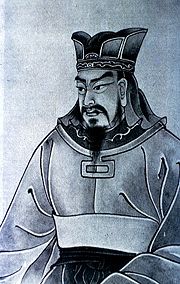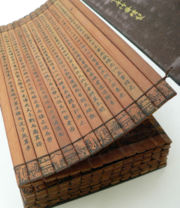Sun Tzu
2008/9 Schools Wikipedia Selection. Related subjects: Ancient History, Classical History and Mythology
| This article contains Chinese text. Without proper rendering support, you may see question marks, boxes, or other symbols instead of Chinese characters. |
Sun Tzu (Chinese: 孫 子; pinyin: Sūn Zǐ) ("Master Sun") is an honorific title bestowed upon Sūn Wǔ ( 孫 武; c. 544—496 BC), the author of The Art of War, an immensely influential ancient Chinese book on military strategy. He is also one of the earliest realists in international relations theory.
In the author's name, Sūn Wǔ, the character wu, meaning "military", is the same as the character in wu shu, or martial art. Sun Wu also has a courtesy name, Chang Qing ( 長 卿; Cháng Qīng).
Biography
Historians debate whether or not Sun Tzu was a real historical figure. In some histories, such as the biography written in the 2nd century BC by the historian Sima Qian, Sun Tzu is born in the state of Ch'i, during the Spring and Autumn Period of China (722–481 BC), and becomes a heroic general for the King of Wu. His victories inspire him to write the Art of War. Other historians place the writing of the Art of War to the Age of Warring States (403–221 BC), based on its description of warfare. It was a time of constant war between seven nations (Chao, Ch'i, Ch'in, Ch'u, Han, Wei and Yen) seeking to control all of China.
According to Sima Qian, the king of Wu tested Sun Tzu's skill, commanding him to train a harem of three hundred sixty concubines. Sun Tzu divided them into two companies, appointing the two concubines most favored by the king as the company commanders. Sun Tzu received giggles when he first commanded the companies, telling them in response that the general is at fault if his soldiers do not understand. He taught the maneuver to them again, and again they laughed and tittered. Sun Tzu ordered the execution of the two favored concubines, to the king's vigorous protest. He explained that if his soldiers understand but do not obey, it is the fault of the officers. Sun Tzu also said once a general receives his orders, it is his duty to carry them out perfectly, even if the king protests. New officers were named and the two companies performed their maneuvers flawlessly thereafter. According to this biography, Sun Tzu further proved his theories on the battlefield with a successful military career and wrote the Art of War based on his tested expertise. His grandson, Sun Bin, also became a famous scholar of the military arts.
The Art of War
The Art of War is said to have been penned by Sun Tzu and was originally called the Sun Tzu Ping Fa (Pinyin: Sunzi Bingfa), or simply the Sun Tzu. It presents a complete philosophy for managing conflicts and winning clear victories. Contrary to popular perceptions, it contains not only the writing of the original author, but also commentary and clarifications from later military philosophers, such as Li Ch'uan and Tu Mu. It is widely accepted as a masterpiece on strategy and has been referenced by generals and theorists throughout history.
The book was not only popular among military theorists, but also among political leaders and business management. The book addresses strategy in a broad fashion, despite the title and popular perceptions, touching upon statecraft and general overarching plans. Theories of battle are essential in times of war, but the text also advocates diplomacy and cultivating relationships with other nations as essential to the health of the state.
Of the texts written before the unification of China, six major works survived, including Sun Tzu's classic. During the Sung Dynasty, these six works were combined with a T'ang Dynasty text into the collected called the Seven Military Classics. As part of that compilation, the Art of War formed the foundations of orthodox military theory in China and was required reading to pass the tests needed for imperial appointment to military positions.
Related text
During the early 1970s, scholars uncovered a large collection of ancient texts written in amazingly preserved bamboo books. Among them was the Art of War and Sun Bin's Military Methods. Although Military Methods was noted by Han Dynasty bibliographies as extant and written by a descendent of Sun Tzu, it had since been lost. The finding of Sun Bin's work was considered an extremely important find, due to a variety of factors including Sun Bin's relation to Sun Tzu and the work's illustration of military thought in late Chinese antiquity. The discovery as a whole expanded the total known Chinese military works by hundreds, though Sun Bin's text is the only known additional surviving text from the ancient period.
Influence and importance
Sun Tzu's Art of War has been deeply influential. It is said the first emperor of a unified China, Qin Shihuang, thought the book invaluable in ending the Age of Warring States. Japan was introduced to Sun Tzu's work c. AD 760, quickly becoming popular among her generals. It is considered an important influence on the unification of Japan. Mastery of its teachings was considered a mark of respect among the samurai and several influential samurai both exhorted and exemplified its teachings, such as Oda Nobunaga, Toyotomi Hideyoshi, and Tokugawa Ieyasu.
In recent times, Napoleon is said to have studied Sun Tzu's military writings and used them to successfully wage war against the rest of Europe. Napoleon's disregard for some of the central principles, such as attentiveness to temporal conditions, is largely credited for his eventual defeat in Russia. Admiral Togo, who led Japan's forces to victory against Russia in the Russo-Japanese War, was famous disciple of the Art of War's teachings.
Mao Zedong partially credited his defeat of Chiang Kai-shek and the Nationalists in 1949 to the Art of War. It strongly influenced Mao's writings about guerrilla warfare, which further influenced communist insurgencies throughout the world. A further example of its explicit modern influence is its use by General Norman Schwartzkopf during Desert Storm, where the general put to practice Sun Tzu's principles of deception, speed, and attacking the enemy's weakness.
A modern interpretation of Sun Tzu and his importance throughout Chinese history is critical in understanding China's push to become a superpower in the 21st century. Hundreds of modern Chinese scholars explicitly rely on historical strategic lessons and the Art of War in developing their theories. They perceive a direct relationship between their modern struggles and those of China in Sun Tzu's time. There is a great perceived value in the teachings of Sun Tzu, and other traditional Chinese writers, and they are used regularly in developing the strategies of the Chinese state and its leaders.

